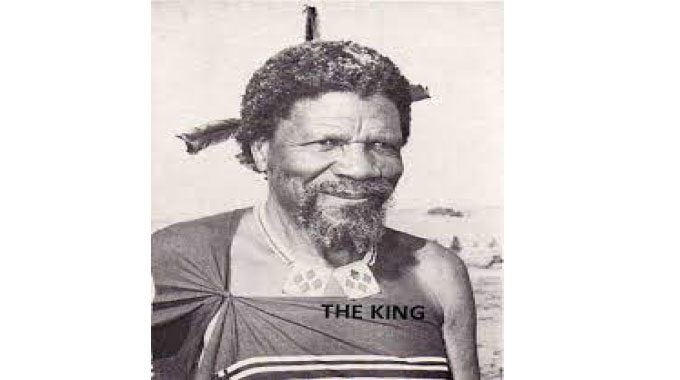
The Sunday News

Mzala Tom
King Sobhuza was born around 1788. He is considered as the founder of modern Eswatini. His father was King Ndvungunye Zikodze, ruler of the Ngwane kingdom. Sobhuza I was also known as Somhlolo.
The name Somhlolo (man of mysteries) is in reference to the mysteries, uncommon wisdom and prophetic gifts that were associated with his life. It is said that on the day that he was born, his father was struck by lightning.
His reign in the early 1800s marked an important phase in the history of Eswatini. As Sobhuza began his reign, the Ngwane kingdom territory was centred along the Phongolo River to the south of modern Eswatini and it’s northern boundaries covered today’s southern Eswatini.
The Ngwane were ruled by the Dlamini dynasty, who had earlier ruled an area around the Lubombo Mountains to the east.
It was then only under Sobhuza’s grandfather, Ngwane III that the Dlamini kings conquered more than 12 clans to establish the country Sobhuza inherited. Early in Sobhuza’s reign, the Ngwane kingdom faced strong attacks and threats of annihilation by the more powerful Ndwandwe and Zulu kingdoms to the south.
The Ngwane were eventually displaced from the fertile lands along the Phongolo River, by the more powerful Ndwandwe.
This was sometime between 1818-19. Sobhuza was forced to move his people and his capital northward into what is now Zombodze, in central Eswatini. The former royal centres in Shiselweni became southern outposts.
On their way north, the Ngwane attacked and scattered the Maseko clan in the great Usuthu valley. The Ngwane also conquered the Pedi. They then settled in the upper Nkomati valley, far from the Ndwandwe threats. In the meantime, Zwide was at war with Shaka in the south.

King Sobhuza
When Zwide fled from the Zulu defeat in 1819, he took his people to Sobhuza’s country around the Upper Nkomati. Sobhuza then withdrew south-eastwards. The Ndwandwe were now too weak to follow and attack the Ngwane. Through diplomacy Sobhuza and Zwide ended up becoming allies.
To seal their alliance, Sobhuza offered to marry Zwide’s daughter Thandile. After securing peace with the Ndwandwe, around 1820, Sobhuza began a more peaceful process of state building, fixing his capital in Usuthu valley.
From this capital, Sobhuza collected regular tribute from the Pedi in the high veld, the Tsonga in the low veld, as well the small Nguni chiefdoms in the middle veld country around Usuthu valley. Sobhuza therefore founded the state known today as Eswatini.
Sobhuza’s kingdom became comparable in scope and power to that of the Zulu. The Swati kingdom was an incorporation of three categories of people groups known as Bemdzabuko, Emakhandzambili and Emafikamuva. This was through Sobhuza’s wisdom and nation building skills.
By the time of his death around 1836/1839, Sobhuza had conquered territories claimed to reach to modern day Barberton in the north, Carolina in the west, Phongolo River in the south and Lubombo Mountains in the east.
Sobhuza I was succeeded by his son Mswati (Mswati II), born by his wife Thandile the daughter of Zwide. Mswati succeeded his father after his death sometime in 1839-40, but only started ruling around 1845 after he was mature and underwent circumcision rites.
Mswati dealt with internal rebellion, pressures resulting from Boer invasions into the eastern Transvaal and land rivalries with Mpande’s Zulu in the Ingwavuma River area. He expanded the control of Sobhuza’s original kingdom, to include much of modern Eswatini lowveld.
Around August 1865, Mswati died prematurely at the height of his success. His successors, Ludvongo and after 1874, Mbandzeni, were unable to preserve Swazi power against Boer land claims and pursuit of minerals.
By 1890, Eswatini had virtually collapsed as an autonomous polity and was preserved from incorporation into the Union of South Africa in 1910, by being colonised by the British in the aftermath of the Anglo-Boer War of 1899–1902.
Mbandzeni (Ngwane V), was succeeded by his son Nkhotfotjeni who became Sobhuza II. At the time of his father’s death around 1899 Nkhotfotjeni was only four months old. His grandmother Labotsibeni and his uncle Prince Malunge led the Swazi nation, until his maturity in 1921. Sobhuza II was recognised as King by the British in 1967, and he led Eswatini to it’s independence in 1968. He reigned until his death in 1982. He was succeeded by the incumbent King Mswati III at age 18 in 1986. King Sobhuza II reigned for 82 years and 254 days.



